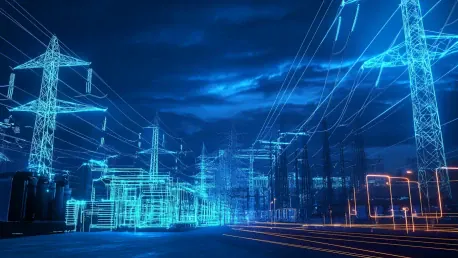North Dakota’s electrical transmission network is the unsung hero behind the state’s lights, power, and modern conveniences. However, the frigid temperatures during February’s cold snap starkly underscored the necessity of a rigorous and dependable power supply. The unyielding winter weather served as a critical reminder of the significant reliance on electricity for healthcare, commerce, manufacturing, energy production, and even national security. Providing an uninterrupted power supply is paramount to maintaining not just comfort but the very backbone of modern life.
Addressing Congestion and Reliability
Basin Electric Power Cooperative Initiatives
A robust and extensive electrical transmission system is imperative to transport electricity from power generators to end users, especially since storing electricity on a large scale remains a technological challenge. Within North Dakota, this intricate task is managed by two regional transmission organizations (RTOs), namely the Southwest Power Pool (SPP) and the Mid-Continent Independent System Operator (MISO). These organizations play an instrumental role in ensuring a smooth flow of electricity by collating data from utility members, conducting grid reliability studies, and proposing necessary expansions to the state’s electrical transmission network.
One of the noteworthy efforts to address the state’s transmission challenges is spearheaded by Basin Electric Power Cooperative (BEPC). Recently, BEPC completed a significant milestone—a 35-mile, 345-kilovolt transmission line stretching from Killdeer to Johnson’s Corner. This addition marked a pivotal development in enhancing grid reliability amidst growing demand and existing transmission congestion. Furthermore, BEPC is in the midst of other ambitious projects, including a substantial 175-mile transmission line from Leland Olds Station to Tioga. This project aims to fortify the electrical backbone essential for reliable service delivery.
Collaborations and Multi-State Projects
In addition to the projects mentioned, BEPC is also collaborating on two 230-kilovolt projects connected to SaskPower. Cross-border cooperation is crucial for maintaining grid robustness and addressing multi-regional power demands. The cooperative efforts envision augmenting transmission capacity to prevent potential overloads and ensure a steady and reliable power supply across state lines.
Another player in this arena, Minnesota Power, has embarked on upgrading its High Voltage Direct Current (HVDC) line. This upgrade is set to increase the line’s capacity from 550 megawatts to a robust 900 megawatts. These enhancements are part of comprehensive strategies aimed at balancing load growth, accommodating new generation facilities, and mitigating transmission bottlenecks. Notably, other infrastructure undertakings include extending a 345-kilovolt transmission line from Mapleton to Big Stone, South Dakota.
Expanding Transmission Capacity
New Transmission Lines
Additionally, the construction of a 525-kilovolt HVDC line extending from Colstrip, Montana, to St. Anthony/Center, highlights a massive leap in advancing North Dakota’s transmission capabilities. This high voltage line is specifically designed to transport large quantities of electricity over long distances with minimal losses, thereby supporting various sectors, including data processing centers, oil and gas refineries, and agricultural operations.
The Otter Tail Power Company and MDU have also introduced plans for a 100-mile long, 345-kilovolt line from Jamestown to Ellendale. These projects collectively address various challenges such as transmission congestion, reliability concerns, and the accommodation of load growth due to both existing and new electricity generation resources. The introduction of these novel transmission lines underscores a unified approach to achieving an energy-secure state.
Economic and Industrial Impacts
Expanded transmission capacity is a linchpin for supporting the delivery of energy to North Dakota’s diverse manufacturing and processing sectors. This includes critical infrastructural components like ethanol plants and soybean and potato processing facilities. By facilitating a stable electricity supply, the new transmission lines portend significant market opportunities for local farmers, thereby engendering a game-changing impact on the agricultural economy. Moreover, the development is poised to significantly benefit the oil and gas sector, which relies heavily on electrical power for various essential operations.
Furthermore, as the push towards electrification of the economy intensifies, ensuring robust and reliable transmission infrastructure becomes even more indispensable. Every business sector stands to gain from low-cost and uninterrupted electricity. Beyond economic advantages, these infrastructure projects are central to promoting a safe and conducive living environment for North Dakota’s residents. Anticipating future electricity demands and preemptively addressing potential power grid vulnerabilities exemplifies the state’s commitment to fostering strong economic growth and energy resiliency.
Unified and Strategic Approach
Overcoming Challenges
Despite facing considerable challenges in expanding the state’s transmission infrastructure, North Dakota remains steadfast in its commitment to responsibly develop its energy resources. This involves constructive engagement with stakeholders, leveraging advanced technologies, and maintaining responsible land and community protections. The North Dakota Industrial Commission plays a pivotal role in these efforts, comprising Gov. Kelly Armstrong (chair), Attorney General Drew Wrigley, and Agriculture Commissioner Doug Goehring.
The commission is dedicated to ensuring that North Dakota’s power supply remains not only reliable but also resilient against unforeseen challenges. These efforts are indicative of a comprehensive approach to effectuate infrastructural advancements without compromising environmental and societal welfare. Ensuring that the state’s transmission infrastructure can withstand and recover from disruptions remains a top priority, and inter-departmental collaborations are crucial for achieving these aims.
Future Considerations
North Dakota’s electrical transmission network is the unsung hero behind the state’s lights, power, and modern conveniences. During February’s cold snap, the frigid temperatures starkly underscored the necessity of a rigorous and dependable power supply. The relentless winter weather highlighted the significant reliance on electricity for various sectors such as healthcare, commerce, manufacturing, energy production, and even national security. This severe cold spell served as a crucial reminder that an uninterrupted power supply is indispensable, not just for comfort, but for sustaining the essential functions of modern life in North Dakota. Ensuring reliable electricity is paramount for the public’s overall well-being and the smooth operation of industries. An effective power infrastructure is vital to maintain the backbone of contemporary life, making it clear that electricity is more than just a convenience—it is a lifeline in today’s interconnected world.









